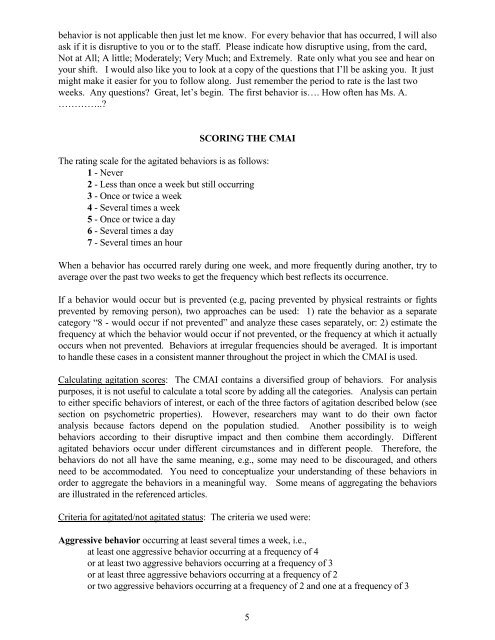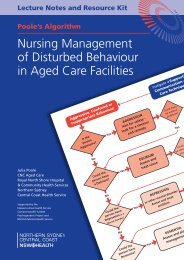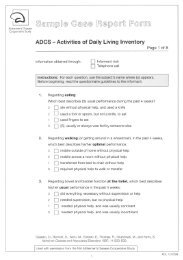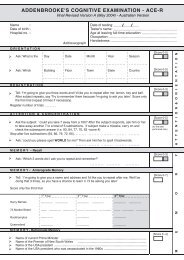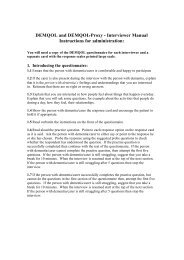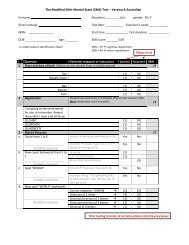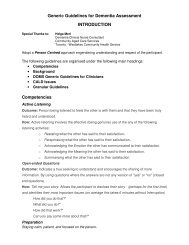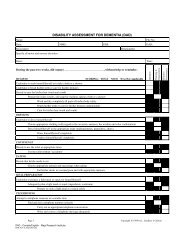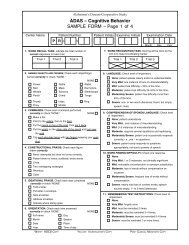Instruction manual for the cohen-mansfield agitation inventory
Instruction manual for the cohen-mansfield agitation inventory
Instruction manual for the cohen-mansfield agitation inventory
You also want an ePaper? Increase the reach of your titles
YUMPU automatically turns print PDFs into web optimized ePapers that Google loves.
ehavior is not applicable <strong>the</strong>n just let me know. For every behavior that has occurred, I will also<br />
ask if it is disruptive to you or to <strong>the</strong> staff. Please indicate how disruptive using, from <strong>the</strong> card,<br />
Not at All; A little; Moderately; Very Much; and Extremely. Rate only what you see and hear on<br />
your shift. I would also like you to look at a copy of <strong>the</strong> questions that I’ll be asking you. It just<br />
might make it easier <strong>for</strong> you to follow along. Just remember <strong>the</strong> period to rate is <strong>the</strong> last two<br />
weeks. Any questions? Great, let’s begin. The first behavior is…. How often has Ms. A.<br />
…………..?<br />
SCORING THE CMAI<br />
The rating scale <strong>for</strong> <strong>the</strong> agitated behaviors is as follows:<br />
1 - Never<br />
2 - Less than once a week but still occurring<br />
3 - Once or twice a week<br />
4 - Several times a week<br />
5 - Once or twice a day<br />
6 - Several times a day<br />
7 - Several times an hour<br />
When a behavior has occurred rarely during one week, and more frequently during ano<strong>the</strong>r, try to<br />
average over <strong>the</strong> past two weeks to get <strong>the</strong> frequency which best reflects its occurrence.<br />
If a behavior would occur but is prevented (e.g, pacing prevented by physical restraints or fights<br />
prevented by removing person), two approaches can be used: 1) rate <strong>the</strong> behavior as a separate<br />
category “8 - would occur if not prevented” and analyze <strong>the</strong>se cases separately, or: 2) estimate <strong>the</strong><br />
frequency at which <strong>the</strong> behavior would occur if not prevented, or <strong>the</strong> frequency at which it actually<br />
occurs when not prevented. Behaviors at irregular frequencies should be averaged. It is important<br />
to handle <strong>the</strong>se cases in a consistent manner throughout <strong>the</strong> project in which <strong>the</strong> CMAI is used.<br />
Calculating <strong>agitation</strong> scores: The CMAI contains a diversified group of behaviors. For analysis<br />
purposes, it is not useful to calculate a total score by adding all <strong>the</strong> categories. Analysis can pertain<br />
to ei<strong>the</strong>r specific behaviors of interest, or each of <strong>the</strong> three factors of <strong>agitation</strong> described below (see<br />
section on psychometric properties). However, researchers may want to do <strong>the</strong>ir own factor<br />
analysis because factors depend on <strong>the</strong> population studied. Ano<strong>the</strong>r possibility is to weigh<br />
behaviors according to <strong>the</strong>ir disruptive impact and <strong>the</strong>n combine <strong>the</strong>m accordingly. Different<br />
agitated behaviors occur under different circumstances and in different people. There<strong>for</strong>e, <strong>the</strong><br />
behaviors do not all have <strong>the</strong> same meaning, e.g., some may need to be discouraged, and o<strong>the</strong>rs<br />
need to be accommodated. You need to conceptualize your understanding of <strong>the</strong>se behaviors in<br />
order to aggregate <strong>the</strong> behaviors in a meaningful way. Some means of aggregating <strong>the</strong> behaviors<br />
are illustrated in <strong>the</strong> referenced articles.<br />
Criteria <strong>for</strong> agitated/not agitated status: The criteria we used were:<br />
Aggressive behavior occurring at least several times a week, i.e.,<br />
at least one aggressive behavior occurring at a frequency of 4<br />
or at least two aggressive behaviors occurring at a frequency of 3<br />
or at least three aggressive behaviors occurring at a frequency of 2<br />
or two aggressive behaviors occurring at a frequency of 2 and one at a frequency of 3<br />
5


